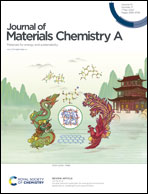Fabrication of hierarchical integrated 3D hollow MnS@MoS2 microcubes via a template-controlled synthesis for asymmetric supercapacitors†
Abstract
Currently, advanced technologies and promising market drive the fast growth of supercapacitors, which poses an urgent requirement for distinctive electrode materials with unique structures and excellent properties. In this work, MoS2 nanosheets are in situ grown onto hollow MnS microcubes, and a 3D hollow hierarchical bimetallic sulfide architecture is prepared with 2D nano-subunits (MnS@MoS2) for supercapacitors. It is novel to couple a covalent assembly strategy with hetero-phase regulation to fabricate MnS@MoS2 with controllable morphology. The characterization and experimental analyses demonstrate the synergy between Mn–S–Mo bonds, and this synthesized material exhibits adequate active sites, short ion diffusion path and improved conductivity. Optimized MnS@MoS2 delivers superior capacitance as an electrode material. Moreover, the assembled asymmetric supercapacitor device possesses an advanced energy density of 64.98 W h kg−1 at 1600 W kg−1 and superior cycling life. This report not only combines the advantages of multiple composites, but also proposes a novel idea for integrating bimetallic sulfides.



 Please wait while we load your content...
Please wait while we load your content...